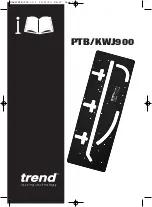
6 ENGLISH
Rotating or replacing blades
Both the upper and lower blades have four cutting
edges on each side (the front and back). When the
cutting edge becomes dull, rotate both the upper and
the lower blades 90° to expose new cutting edges.
When all eight edges are dull on both the upper and
lower blades, replace both blades with new ones. Each
time blades are rotated or replaced, proceed as follows.
►
Fig.3:
1.
Hex wrench
2.
Loosen
3.
Upper blade
securing bolt
4.
Lower blade
5.
Upper blade
Remove the blade securing bolts with the hex wrench
provided and then rotate or replace the blades.
►
Fig.4:
1.
Blade holder
2.
Thin washer
3.
Upper
blade
4.
Upper blade securing bolt
Some tools have one washer between the upper blade
and the blade holder.When the tool has the washer, be
sure to use the thin washer when reassembling.
NOTE:
•
No thin washers are used for the lower blade.
►
Fig.5:
1.
Upper blade securing bolt
2.
Tighten
3.
Upper blade
Install the upper blade and tighten the upper blade securing bolt with
the hex wrench. Press up on the upper blade while tightening it.
►
Fig.6:
1.
Blade holder
2.
Upper blade securing bolt
3.
Upper blade
4.
No gap allowed
After securing the upper blade, be sure that there is no gap left
between the upper blade and the beveled surface of the blade holder.
►
Fig.7:
1.
Tighten
2.
Lower blade
3.
Yoke
When installing the lower blade onto the yoke, the lower blade
should be pressed against the yoke so as to be contacting the bev
-
eled portions A and B of the yoke and the tip C of the lower blade
positioning screw while you tighten the lower blade securing bolt.
There must be no clearance between A, B and C during installation.
NOTE:
•
The lower blade positioning screw is factory-as
-
sembled. Do not tamper with it.
►
Fig.8:
1.
Yoke
2.
Lower blade positioning screw
3.
Lower blade
OPERATION
Holding material and shearing method
WARNING:
•
Before operating the tool, be sure to firmly tighten
the upper blade securing bolt and the lower blade
securing bolt. Loosen bolts may cause blades
coming off, resulting in a serious injury.
•
When cutting, always place the shear on the
workpiece so that the material cut away is posi-
tioned on the right side to the operator.
The materials for cutting should be fastened to the
workbench by means of workholders.
►
Fig.9
Always hold the tool firmly with one hand on housing.
Do not touch the metal part.
Keep the shear moving parallel with the material.
Maximum cutting width
►
Fig.10:
1.
Cutting line
Stay within the specified maximum cutting width (A):
Case of length 1,800 mm.
Mild steel (thickness)
1.6 mm
Under 1.2 mm
Max. cutting width (A)
100 mm
No limit
Stainless (thickness)
1.2 mm
Under 1.0 mm
Max. cutting width (A)
80 mm
No limit
Minimum cutting radius
Minimum cutting radius is 30 mm when cutting 1.0 mm
mild steel.
MAINTENANCE
CAUTION:
•
Always be sure that the tool is switched off and
unplugged before attempting to perform inspec
-
tion or maintenance.
•
Never use gasoline, benzine, thinner, alcohol
or the like. Discoloration, deformation or cracks
may result.
To maintain product SAFETY and RELIABILITY,
repairs, carbon brush inspection and replacement, any
other maintenance or adjustment should be performed
by Makita Authorized Service Centers, always using
Makita replacement parts.
OPTIONAL
ACCESSORIES
CAUTION:
•
These accessories or attachments are recom-
mended for use with your Makita tool specified
in this manual. The use of any other accessories
or attachments might present a risk of injury to
persons. Only use accessory or attachment for
its stated purpose.
If you need any assistance for more details regard-
ing these accessories, ask your local Makita Service
Center.
•
Shear blades
•
Hex wrench
•
Wrench holder
NOTE:
•
Some items in the list may be included in the
tool package as standard accessories. They
may differ from country to country.
Содержание 0088381634113
Страница 3: ...1 800 mm 70 7 8 A 1 Fig 9 Fig 10 3 ...





































